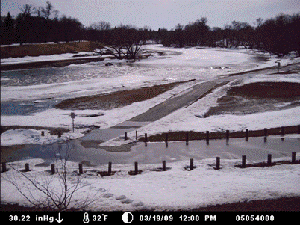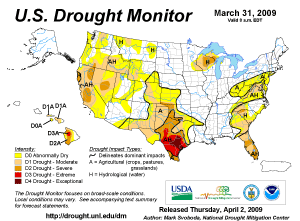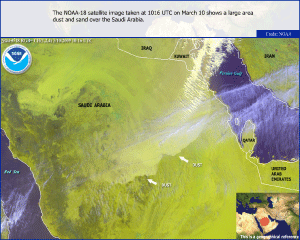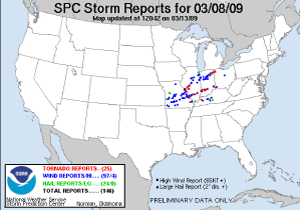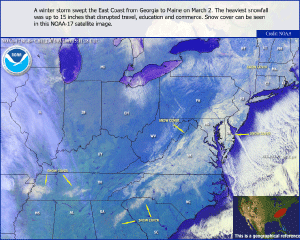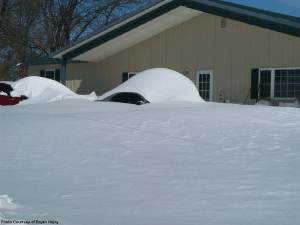
Global Hazards and Significant Events
March 2009
The Red River along the North Dakota and Minnesota border brought record flood levels to the Fargo, ND and Moorhead, MN city area. Additional information can be found below.

In the U.S., moderate to severe drought was present across the West and parts of the eastern continental United States. Meanwhile, severe to exceptional drought conditions engulfed much of Texas. As of March 31, 25% of the contiguous U.S. was in moderate to exceptional drought according to the U.S. Drought Monitor. This includes 28% of the western U.S., 48% of the South, 8% of the High Plains, and 35% of the Southeast. For a complete drought analysis across the United States, please see the U.S. Drought page.
The Saudi Arabian capital, Riyadh, experienced one of the most powerful sandstorms in decades on March 10. According to reports, visibility was reduced from kilometers to a few meters in seconds. The storm caused school closings and flights delays (BBC News).
According to a report released 31 March 2009, Somalia's severe drought conditions intensified. The most affected areas were central and southern Somalia. The lack of potable water prompted people to drink untreated water, causing sickness and death. The conditions also caused livestock to perish and the cost of drinking water to increase significantly as donkeys used to ferry water died (IRIN).

Resulting from heavy rains, a deadly landslide on March 2 claimed the lives of 13 people and left 17 others missing in Peru's southeastern region of Puno (BBC News).
In Papua New Guinea, heavy downpours triggered a landslide that killed seven people on March 3 (AFP).
During the first two weeks of March, southern Angola was drenched by heavy rains, causing floods that affected nearly 125,000 people in its Cunene province and washed away homes and livestock (BBC News).
A 76-year-old dam burst on March 27 as heavy rain fell over the Indonesian capital of Jakarta, wreaking havoc across the affected area. The wall of water engulfed hundreds of homes as residents slept. Homes were flooded and damaged, telephone lines were downed, cars were swept away, and 77 bodies were recovered, while over 100 people were still missing and nearly 180 others were injured (Associated Press/Reuters).
In the United States, parts of Bismarck, North Dakota experienced localized flooding during the week of March 22. The flooding, which resulted when an ice jam obstructed the Missouri River, was the Bismarck area's first major flood event since the 1950s (Associated Press).
In the northern Plains region of the U.S., saturated and frozen ground, exacerbated by snowmelt and additional snowfall, caused the Red River along the North Dakota and Minnesota border to swell. On March 28, the river crested in Fargo at a record level of 12.4 m (40.8 feet), just 0.2 m (9.0 inches) below the city's highest levees and surpassing its previous record of 12.2 m (40.1 feet) set in 1897 (AFP). An estimated 3,500 people were evacuated from the area and as many as 25,000 more were expected to leave. A state of emergency was declared in North Dakota and Minnesota (AFP). As of March 31, two fatalities, 50 injuries, and 82 rescues were reported in flood-related incidents (CNN).

Severe storms raked the midwestern U.S., spawning 25 preliminary reports of tornadoes on March 8. In Fayetteville, Indiana, vicious winds damaged 19 homes and destroyed 3 others and, according to reports, the high winds tossed a vacant school bus onto a building. In Columbia City, Indiana, three trailers were destroyed with 20 others damaged at a mobile home park. The storms were also responsible for other damaged homes across the Midwest and for downing power lines that resulted in thousands of people losing electricity across central Illinois (Associated Press).
Vicious storms spawned a deadly tornado that ripped through Orissa, in eastern India, on March 31. According to reports, the tornado lasted for an hour, leaving a trail of destruction as it swept through 11 villages. More than 300 homes were damaged, trees were uprooted, and power lines were downed. Fifteen fatalities were reported, along with over 150 injuries (Xinhua/BBC News).
In the U.S., spring storms on March 28 brought a mix of severe weather which extended from the Great Plains down to the Gulf Coast. In Kansas and Oklahoma, heavy bands dumped several feet of snow and brought brief periods of thundersnow. In neighboring Missouri, freezing rain and snow caused a 2-hour closure of the Kansas City International Airport. Several meat plants, including Tyson Foods Inc., were forced to stop operations (Reuters). While winter weather blanketed these states, thunderstorms and flash floods tore through Alabama and Mississippi, leaving up to 431.8 mm (17 inches) of rain within a 3-day period in some areas. In Biloxi, more than 200 homes sustained flood damage and hundreds of roads in the area were deemed impassable due to washouts. Overall, two snow-related fatalities were reported in Kansas and three injuries in Tennessee from wind damage. Only two days before, nearly 30 injuries were reported in south-central Mississippi from a tornado outbreak across the South (Associated Press).

No significant tropical cyclones reports were received during March 2009.
For 2008 basin tropical cyclone statistics, please refer to the following:
Australian Basin
North Indian Ocean Basin
Western North Pacific Basin
South Pacific Basin
South Indian Ocean Basin
East North Pacific Ocean Basin
Atlantic Basin

No significant extratropical cyclones reports were received during March 2009.

A major winter snowstorm affected the eastern United States during March 1-2, blanketing the region and bringing high winds. The storm stretched from northwestern Georgia to New Hampshire, producing treacherous conditions that caused the cancellation of schools and nearly 1,000 flights, and left hundreds of thousands of residents without power (Associated Press/Reuters). Snow accumulations up to 30.5 cm (12.0 inches) were recorded across parts of the affected regions, with more than 170 daily snowfall records set during this period. The storm was blamed for more than 400 storm-related traffic accidents across the northeastern U.S., with four resulting in deaths (Associated Press). For more information on the U.S. snowfall records, please visit the U.S. Records page.
A spring blizzard struck parts of the southern Plains during March 26-28, dumping as much as 38.1 cm (15.0 inches) of snow in northern Texas, 61.0 cm (24.0 inches) in western Oklahoma, and over 50.8 cm (20.0 inches) across parts of Kansas. Amarillo, TX received 27.9 cm (11.0 inches) of snow during the event, ranking as the fifth largest snowfall from a snowstorm in Amarillo during the month of March. The storm was blamed for two deaths in Kansas, and two traffic-related fatalities and for leaving nearly 6,000 residents without power in Oklahoma (Associated Press). In Texas, the blizzard was responsible for closing major highways and causing numerous accidents. However, no fatalities were reported in Texas. Twenty new all-time snowfall records were established and eight were tied during March 2009. For March all-time snowfall records, please visit the U.S. Records page.
On March 30-31, a large storm system affected the northern Plains causing blizzard conditions from Colorado into west central Minnesota. It was the second snowstorm to hit the region within a week's time. Snow totals of over a foot were common, with as much as 68.6 cm (27.0 inches) in some locations. These significant accumulations combined with high winds to create snowdrifts up to 1.8 m (6.0 feet) in such areas as Sheridan, Wyoming. In Fargo, a new monthly record snowfall of 71.4 cm (28.1 inches) replaced the previous March record of 66.5 cm (26.2 inches) set in 1997. Snow in this region only worsened the Red River Valley flooding, as the snowpack's high liquid equivalent translated into as much as 50.8 mm (2.0 inches) of liquid (National Weather Service). Six fatalities were reported in association with this winter storm, including 3 traffic-related deaths in the Denver area where an 18-vehicle pileup occurred (Associated Press).
A massive storm, which extended from Canada to the Gulf of Mexico, brought heavy snow to parts of the Dakotas and hail to parts of Texas on March 31. Bismarck, ND received 43.2 cm (17 inches) of snow, which brought the seasonal total snowfall (as of 1 April 2009) to 254.5 cm (100.2 inches), just 3.6 cm (1.4 inches) shy of tying the seasonal total snowfall record set in 1996-1997. Meanwhile, March 2009 tied with March 1950 as the fifth largest monthly snowfall, when a total of 75.4 cm (29.7 inches) fell over Bismarck. Hail battered parts of the southern Plains, resulting in reports of damage to roofs and cars in Dallas, TX (Associated Press).
For more information on the U.S. Snow and Ice events, please visit the U.S. Snow and Ice Winter 2008/2009 page.
 NOAA's National Centers for Environmental Information
NOAA's National Centers for Environmental Information
